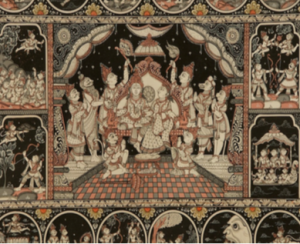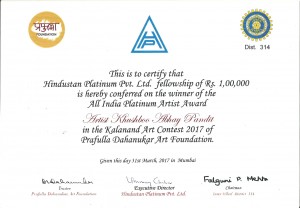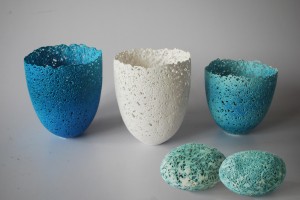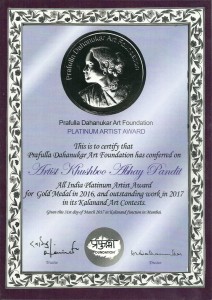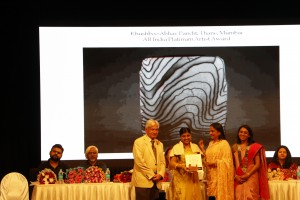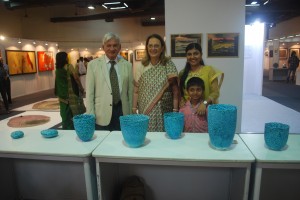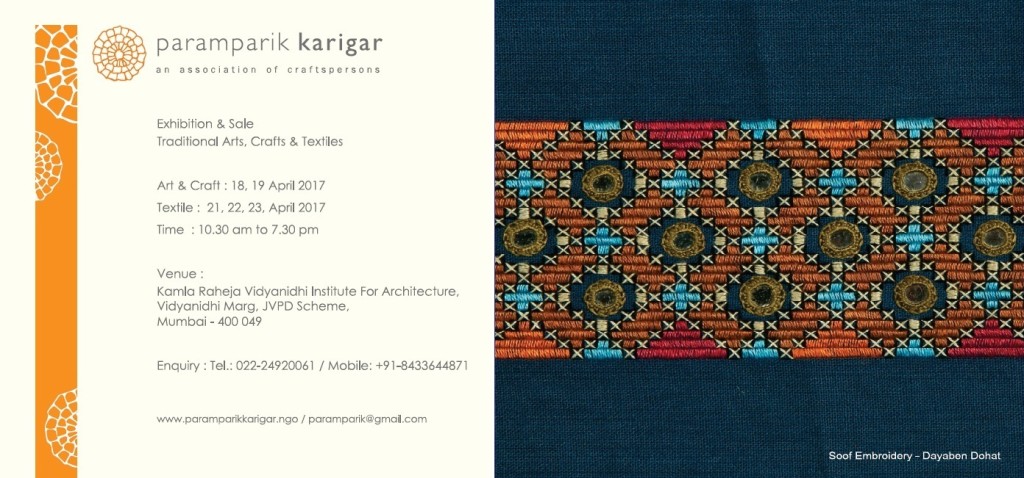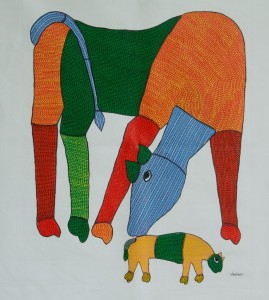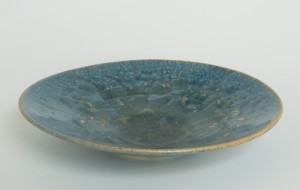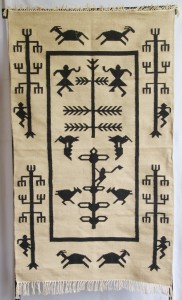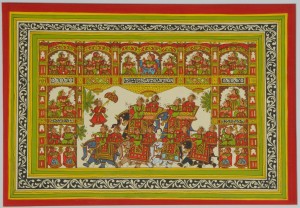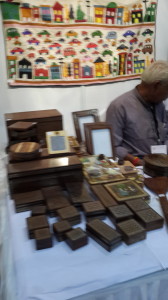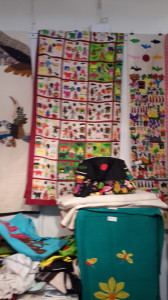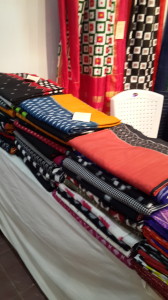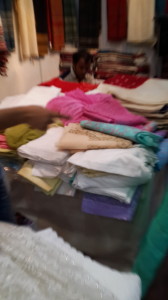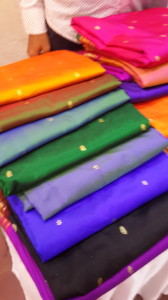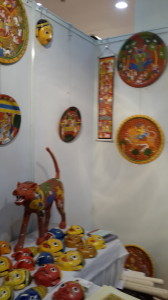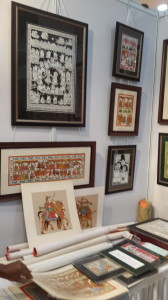Cont from part I
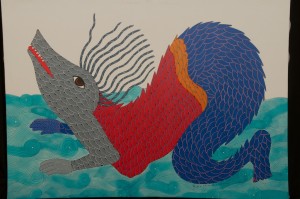
A Historical Perspective :
This eponymous painting style is a folk/ tribal art form practiced by The Gond Tribes, largely from Madhya Pradesh. The word, ‘Gond’ comes from the Dravidian expression, Kond which means ‘the green mountain’.
Painting in the region can probably be dated back to 1400 AD, the time when the history of the Gond people starts to appear. However, it is also possible, some experts say that it could be even more ancient than that- it could be a continuation of the cave paintings of their ancestors, a possibility suggested by the cave paintings in the region that go all the way back to the Stone Ages, Bhimbetka being an example.
The Gond people have a belief that viewing a good (auspicious) image begets good luck. This belief led the Gond people to decorate the walls as well as the floor of their houses with traditional tattoos and motifs. Digna and Bhittichitra (frescos) paintings are painted by the tribal people on floors and the walls of their houses Gond paintings have also been used by the Gond people as a way to record their history.
The Gonds traditionally painted on mud walls of their houses Gond wall decorations are made with a thick stick dipped in mud or clay mixed with chaff and water. When a house is under construction, the mud wall is kept damp for patterns to be imposed on it, which is then covered with cow dung or lime.
Mostly orally transmitted, Gond iconography has now, found representation in their colourful and vibrant art.
Gond Art Today
Starting in the early 1980s, certain talented Pardhan Gonds, who traditionally serve as professional bardic-priests, began transforming their ritual performing arts into a new tradition of figurative and narrative visual art: using a variety of modern media (including acrylic paintings on canvas, ink drawings on paper, silkscreen prints, and animated film) they have created unprecedented depictions of their natural and mythological worlds, traditional songs and oral histories
A rich visual narrative imagery thus evolved from juxtaposed forms from the folklore.
Some tales from their Charming folklore:
The story of Shiva and Mahua
Once while walking through a forest, Lord Shiva, the God of Destruction, was tempted by the shade of Mahua tree and longed to rest a while. As he settled himself under the tree, tired and thirsty as he was, he happened to see some water that had collected in one of the hollows of the tree. Now, the Mahua fruit is well known as an intoxicant. The hollow in the tree also contained some over-ripe mahua fruit and when Shiva drank it, he quickly became mildly and pleasantly inebriated. The ‘water’ tasted delicious – cool and sweet and scented by the mahua fruit, and soon Shiva was drinking from it again and again!
As his intoxication grew, Shiva went from babbling like a parrot (lost control over his tongue!), to becoming aggressive and intimidating, like a tiger, and then finally lost all control and rolled in the dirt like a boar, grunting and growling without a thought to his standing or position….It is an interesting tale, and not just at one level…it cautions one of the dangerous effects of over-imbibing alcohol, persuading you to consider that if Shiva himself was reduced to an animal, what chance have you, a mere mortal, to have dominion over yourself when under the influence of intoxicants.
This story is usually depicted with the God, the tree and the animals.
The Peacock and its Ugly Feet
Another Gondi folktale tells the story of how God resolved to create the universe in just fourteen days. Over the first seven days, he created the earth and the skies and then filled the space between them with all the plants and animals. God wanted, in that the universe, a piece of unsurpassable beauty and he had seven days to make it. After much thought, he came up with the creature we call the peacock.
Making this new creature was painstaking and time-consuming work – the body, the sharp eyes, the resplendent plumage took six and a half days. Now God had just half a day to make the creature’s feet. Pressed for time, God did a hasty job with the feet. The creature was completed just as the fourteenth day ended and the result was a little incongruous- a spectacularly beautiful creature with ungainly feet. However, the ugly feet serve a deeper purpose- of keeping the vanity of even the most beautiful creation of God in check.
Udata Hathi or the Flying Elephant
This Gond folktale tells the story of the winged elephant (Udata Hathi) that was used by Gods and Goddesses in heaven, to transport them from place to place. One day, when the Lord was resting he told the elephant to take a break. The elephant flew down to the earth. There he found fields of sugarcane and banana trees. He gave into temptation and started eating the sugarcane. The villagers became angry and alarmed. They tried to scare him away. But the elephant would not move. The villagers then called out to the Lord for help. The Lord appeared and was displeased with the Elephant. He ordered the Elephant to never to go to earth again. But the Elephant had now tasted the forbidden fruit and couldn’t stay away. He went back to Earth to eat the sugarcane. The villagers once again turned the Lord for help .This time Lord was furious. He told the villagers to organize a feast and to invite the Elephant to it. The Elephant came to the feast . The delicious feast and the accompanying Mahua wine made the elephant fell asleep. Whilst he was asleep, the Lord cut off his wings .He gave one to the Banana tree and one to the Peacock. From that day the Peacock has a beautiful Plumage and the Banana tree has large leaves.
Some Interesting Facts for the Trivia Buff :
According to the Gond belief system, each and everything whether it is a hill, river, rock or a tree is inhabited by a spirit and, consequently, is sacred. So the Gond people paint them as a form of respect and reverence. It can also showcase abstract concepts like emotions, dreams and imagination.
Gond paintings bear a remarkable likeness aboriginal art from Australia as both styles use dots to create the painting.
Gond Art on the left, Aboriginal art on the right
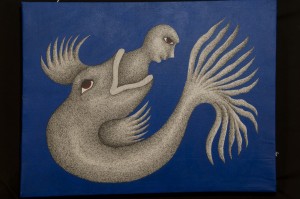
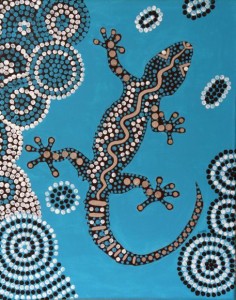
Sources :
Paramparik Karigar Archives
http://www.deccanfootprints.com/collections/gond-art#
http://www.utsavpedia.com/motifs-embroideries/gond-painting/
http://indiantribalzone.blogspot.in/p/gond-art.html
Did you like this? Share it easily:

